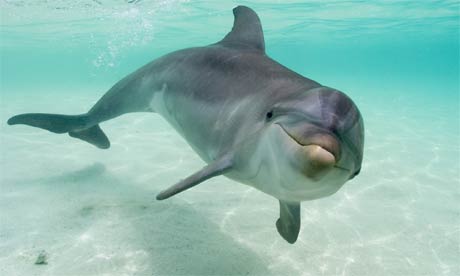The Cove is guerrilla journalism at its best. Structured and paced by director Louie Psihoyos as a thriller/caper movie, it brings audience-grabbing cinematic conventions to work in telling its story of dolphin genocide. It’s a movie that should be seen by everyone, but it’s not the sort of date movie that brings couples out on a Saturday night.
The star of the movie, and the conscience of the drive to halt the slaughter of these aquatic mammals, is Ric O’Barry, a grizzled activist who as a young man caught and trained the dolphins who performed as Flipper on the wildly popular ’60s TV show. Today, O’Barry’s handsome features wear a look of perpetual contrition for his complicity in inspiring the multi-million dollar international trade in the capture and exploitation of these sensitive, intelligent, and friendly creatures.
“The thing that turned me around was the death of Flipper,” he says. He’s talking about Cathy, one of the five females who played the iconic television dolphin. “She committed suicide in my arms.” Cynics may question the choice of words, but it’s unlikely that any of them know dolphins the way O’Barry does. “She looked me right in the eye, took a breath – and didn’t take another one. She just sank to the bottom.”
From that day, O’Barry became an activist in the battle to save and free the dolphins. And that campaign has taken him many times to the little Japanese whaling village of Taiji, where much of this documentary takes place. He describes the place as “a little like The Twilight Zone.” Schools of dolphin are herded by a flotilla of fishing boats banging on submerged pipes. The dolphins, who possess extraordinary hearing, flee in terror and are driven into a lovely secluded cove, and trapped there. Trainers from around the world look them over and buy the most appealing ones for aquatic shows. The going rate for a dolphin is as high as $150,000 per, and the animals return many times that as attractions in places like Sea World, where dolphin-loving tourists sit in stadia and watch them perform. (The film describes a park in Japan where spectators watch the dolphin act while munching on dolphin-meat snacks from the concession stands.)
The rest are slaughtered. And it is this that has brought O’Barry and his team of guerrilla activists to Taiji.
The cove is barricaded with chain-link fences, razor wire, and guards. And this is where O’Barry and Psihoyos bring their carefully assembled team of eco-commandos and specially-made equipment to record the horrors that transpire out of sight of prying public eyes. They have hi-def cameras secreted inside fake rocks constructed by a sympathetic team at George Lucas’s ILM shop, which they plant on the beach, in the cliffs above, and in the waters of the cove. The infiltration is recorded with a variety of techniques, including infra-red film, and urgent radio communications of the “They’ve spotted us! Get out now!” variety add the spice of a Bourne adventure to the operation.
The footage O’Barry’s team captures makes it clear why the Japanese have gone to such lengths to keep him out. The slaughter is appalling, and individual shots of a bleeding dolphin frantically trying to leap or break through the nets, another making a hopeless run at the beach, are heartbreaking. The carnage is relentless, and the waters of the cove turn red with blood. It’s like a scene from a horror film, or a Saving Private Ryan moment, but the blood is real.
Why do we care? It’s no worse than a slaughterhouse, which of course is something else we would rather not see. The difference is that dolphins have a claim to intelligence that has been extensively researched. They may be far more intelligent than we know. They are self-aware – O’Barry describes bringing a tv set down to the tank so the Flipper cast could watch themselves, and discovering that Cathy and the others recognized themselves on the screen. Dolphins appear to communicate, and they are demonstrably friendly to humans and others. Back in the second century AD, Plutarch observed that “to the dolphin alone, beyond all other, nature has granted what the best philosophers seek: friendship for no advantage.” In the film, an Australian surfer tells of a dolphin who saved him and a surfing buddy from a shark. There are many such stories.
So when we see these creatures being captured and culled for sale to amusement parks and swim-with-the-dolphins attractions, we can’t help thinking of the slave trade; and when we see the less desirable ones slaughtered, it’s hard to avoid the comparison to extermination camps.
Why are they slaughtered? Apparently for meat, although their flesh is toxically high in mercury. Sometimes it is deliberately mislabeled and sold as whale meat. It was served in mandatory school lunches in Japan until a couple of gutsy city councilmen in Taiji exposed and halted the practice.
The Japanese fishermen, and the government, complain that activists like O’Barry are Western cultural imperialists trying to impose their values on a culture they do not understand. The participation of more Japanese, especially on the commando team, would have blunted this charge, but they’re not in sight. And there are issues of context that could be expanded on to give us a better view of the big picture.
Meanwhile, the Japanese government and media continue to protect and cover up these practices. Japan bribes impoverished countries into backing their predatory practices in the International Whaling Commission, a sort of Coalition of the Whaling. And dolphins continue to be slaughtered at the rate of something like 23,000 a year worldwide.
Mitchell Englander


